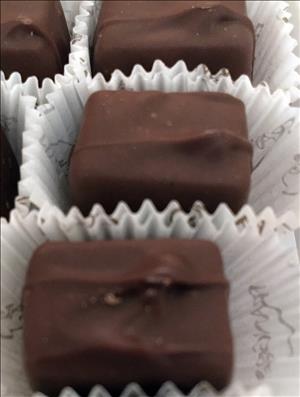On June 1, 1918, a trademark document is submitted to the United States Patent Office for the name Frango. Originally used as the name of a frozen dessert served at the Frederick & Nelson department store in Seattle, it later is attached to small mints that quickly become a commercial icon for the Pacific Northwest, and a taste treat around the nation.
Just Dessert
The trademark was applied in preparation for the opening of the new Frederick & Nelson store at the corner of 5th Avenue and Pine Street in Seattle. When the store opened on September 3, 1918, it boasted a tearoom in which fashion shows were held for the enjoyment of the shoppers while they had lunch. Many diners finished their meal with a Frango, a frozen dessert that came in one of two flavors: maple and orange.
The flaky confection was made with 32 percent butterfat -- triple the amount in regular ice cream. It is unsure how the name Frango originated, although the "Fr" may have been used to tie in the name with Frederick.
In 1921, the store opened a candy kitchen, under the direction of Ray Clarence Alden. After a few years of selling hard candies and dipped chocolates, it was decided that a chocolate mint truffle might be a tasty addition. After some trial-and-error recipes, Alden concocted a treat made from cocoa beans, peppermint, and 40 percent butter. The Frango Mint was born.
Delighting the Nation
The tasty morsels were a huge success, aided by heavy promotion from Gil Ridean, head of Frederick & Nelson's Food Division. Packed in a green and white, eight-ounce tin, Frangos became the perfect gift for any occasion. Priced at 50 cents a tin, the sweets were both elegant and inexpensive.
When Donald Frederick sold his interest in the store to Marshall Field in 1929, Ridean and the candy staff went to Chicago to introduce the mints to executives. Marshall Field began producing its own version, and the candies began selling all over the country. Frederick & Nelson was the distributor west of the Mississippi, and Marshall Field covered the rest of the nation.
Whither Frangos?
When Frederick & Nelson filed for bankruptcy in 1991, Frango lovers throughout the Northwest feared a candy crisis and began hoarding their beloved truffles. During that year's Christmas season, lines formed around the block. Once the doors opened, the crowd dashed for the candy counter, while other sections of the store remained bereft of consumers.
In 1992, Frederick & Nelson closed its doors for good, but continued to operate the candy kitchen. Marshall Field fought for the right to distribute the mints nationwide, but another Seattle-based store -- the Bon Marche' -- stepped in for the licensing rights. The two stores worked out an agreement, and the Bon was given permission to sell Frangos at its stores in Washington, Idaho, Montana, and Oregon.
The agreement was made just in time for the 1992 Christmas season, and local sweet-tooths heaved a sugary sigh of relief. On November 5, 1992, Seattle Mayor Norm Rice held a ceremony at the Bon Marche' proclaiming the day as Frango Day. Frangos continued to be made and sold in the city in which they originated.

